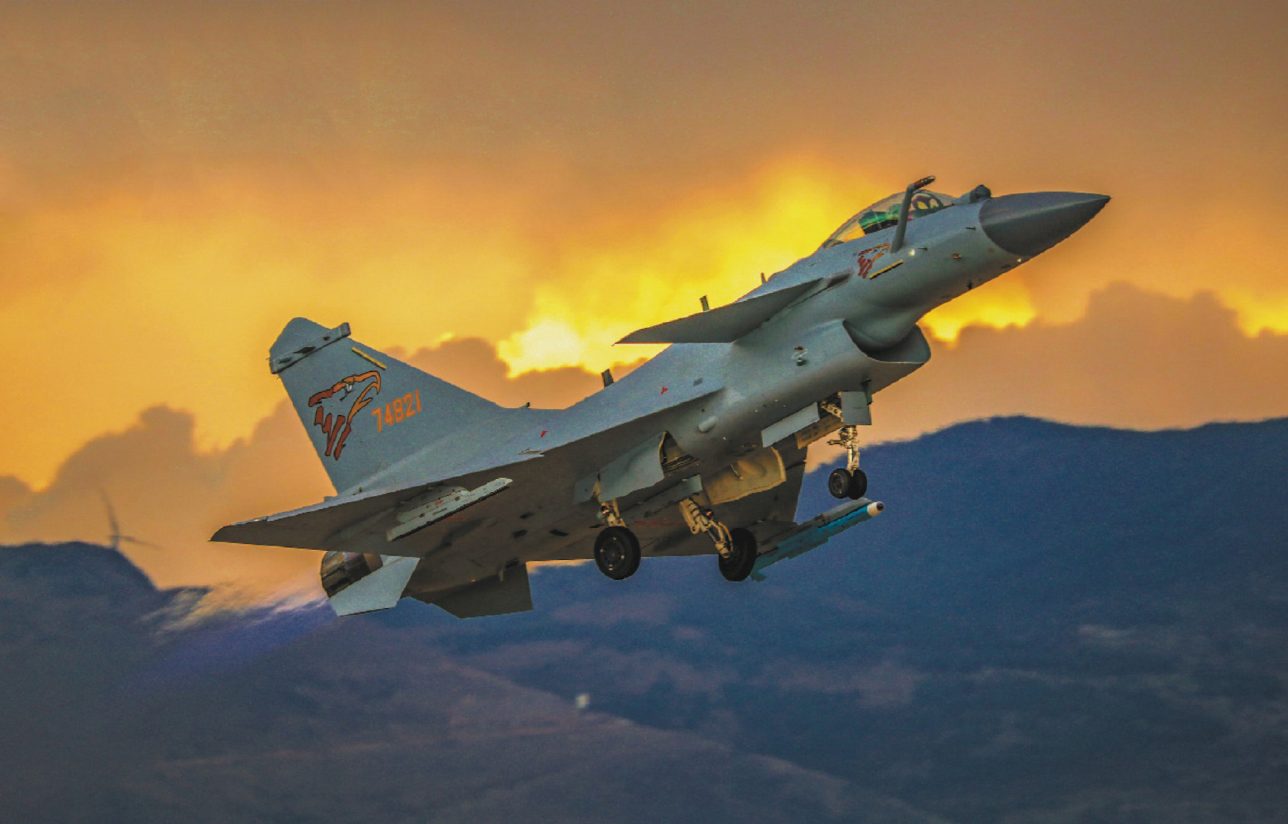The interception of the Royal Canadian Air Force (RCAAF) CP-140 patrol aircraft off the Chinese coast by the J-10 has brought to the fore the efficacy and tremendous utility of the single-engine fighter for the Chinese People’s Liberation Army Air Force (PLAAF).
US B-52s ‘Respond’ To Russian Tu-95 Bombers; Hold Joint Drills With Japan After RuAF Muscle-Flexing
A J-10 has probably never been employed for such interceptions in the past. A Su-30MKK was also accompanying the J-10, seen in the video shot from inside the CP-140 Aurora. The J-10 version that conducted the “unsafe and unprofessional” interception was the J-10AS, seen in the more exposed ventral air intake design.
In the video shot from inside the CP-140, Major General Ian Huddleston of the RCAF could be heard saying the J-10 is “20 feet” away from the wing’s port (left) side. The plane could be seen coming in from the starboard (right) side, presumably going from the front of the plane, drifting to its port side.
Responding to a journalist’s question whether this was an “aggressive intercept,” Huddleston responds in the affirmative, saying they would consider it a “level three.” However, it is unclear what level of safety the categorization denotes regarding Canadian military aviation norms. That the pilot did not “waggle” his wings and was “stable” makes it an “unusual” intercept.
J-10, A Force To Reckon With!
The Pakistan Air Force (PAF) has inducted the J-10’s most advanced ‘C’ variant, which sports sophisticated electronics and avionics, landing it firmly in the Generation 4.5 category. The PAF acquired the plane to maintain parity with the Indian Air Force (IAF) after it acquired the Dassault Rafale.
More than a force multiplier, the advanced J-10C variants can multirole interception that enemy fighters over the western Pacific will have to contend with after dealing with the J-16s, J-11s, J-20s, or the carrier-borne J-15s.
According to retired Pakistan Air Force fighter pilot Squadron Leader Ali Hamza, for frontline air dominance/air superiority roles, the J-10C can also be paired with the J-16s or even the Su-35s recently purchased from Russia, communicating target information on data links.

The J-10AS that conducted the intercept was a two-seat variant. According to leading Chinese military researcher Andreas Rupprecht, the J-10AS in the video is a modified version re-engined with the WS-10B and assigned to the 34th Air Brigade.
Superior to India’s LCA Tejas Mk.1 and roughly comparable to the F-16’s advanced Block 70/72 variants, the J-10Cs can also fire the PL-15 air-to-air missile (AAM), claimed to have a range between 200 to 300 kilometers.
Hamza believes this capability — to fire Beyond Visual Range (BVR) missile — is decisive. “Aircraft have become secondary, and BVR is the primary aspect of any combat. For instance, an F-16 carrying an AIM-120D Advanced Medium Range Air-to-Air Missile (AMRAAM) will be more lethal than an F-15 carrying an AIM-120D,” he told EurAsian Times.
A Royal Canadian Air Force CP-140 Aurora was intercepted by a PLAAF J-10 fighter jet off the coast of China Monday. A Canadian news crew was onboard to capture the intercept. pic.twitter.com/m93ehW9RJr
— Thenewarea51 (@thenewarea51) October 17, 2023
The J-10 is also being produced on a broader scale than any other type, with Pakistan starting to form its first unit in February 2022 and China reportedly already fielding over 200.
It features a wide delta wing and two canards directly behind the cockpit for excellent maneuverability. The weaponry is comparable to the MiG-29 and F-16, with three weapon pylons on each wing and three in the belly. The J-10C variant is powered by the indigenously manufactured WS-10 Taihang engine, as earlier reported by the EurAsian Times.
J-10AS & Su-30MKK Teaming?
The incident, however, does offer any hint at how the PLAAF might deploy its fighters in the event enemy aircraft manage to come close to the coastline. The J-10’s older ‘A’ variants would appear to be the last line of defense, possibly even acting as ‘point defense’ fighters, not undertaking the frontline air superiority/air dominance roles.
Hamza believes this could be true for the older J-10s, given its slightly less advanced avionics. “It is likely the older J-10As could be paired with vintage J-7s and J-8s closer to the mainland,” Hamza said.
Nevertheless, the Su-30MKK, the original Russian-made jets that United Aircraft Corporation (UAC) developed and built specifically for China in the mid-1990s, hints at how the PLAAF might use the aircraft.
It cannot be ruled out that the J-10AS and the Su-30MKK could be a part of an established ‘teaming’ formation. Two planes of different types are paired to coordinate and conduct operations based on their strengths and capabilities. Such a possibility cannot be ruled out either.
Older aircraft being employed as ‘missile trucks’, carrying the heavier loadout of missiles and firing them on enemy formations after receiving targeting data from advanced jets, is a common practice.
While the PLAAF inducted J-10AS by 2005, the Su-30MKKs began reaching PLAAF units between the late 1990s and early 2000s. The J-10C, meanwhile, was reported to start getting operationalized in the PLAAF in late 2021.
But in a war in the western Pacific, the likelihood of Allied and Chinese jets coming into contact is often doubted. “If we bring in China’s long-range anti-access/area-denial (A2/AD) ballistic, cruise, and anti-ship missiles targeting enemy air bases and aircraft carriers, most of the aircraft will be destroyed on the ground before any aerial action,” Hamza said.
- The author can be reached at satamp@gmail.com
- Follow Eur Asian Times on Google News